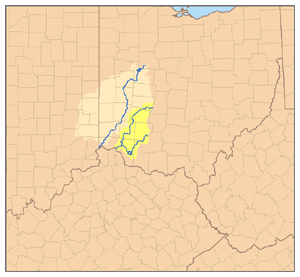Great Miami River
| Great Miami River | |
|---|---|
 The Great Miami River near Vandalia | |
| Location | |
| Country | United States |
| State | Ohio, Indiana |
| Counties | Logan, Shelby, Miami, Montgomery, Warren, Butler, Hamilton in Ohio; Dearborn in Indiana |
| Physical characteristics | |
| Source | |
| • location | Indian Lake, Russells Point, Logan County, Ohio |
| • coordinates | 40°28′04″N 83°52′33″W / 40.46778°N 83.87583°W[1] |
| • elevation | 998 ft (304 m) |
| Mouth | |
• location | Ohio River, Miami Township, Hamilton County, Ohio |
• coordinates | 39°06′31″N 84°48′52″W / 39.10861°N 84.81444°W[1] |
• elevation | 449 feet (137 m)[1] |
| Length | 170 miles (270 km) |
| Basin size | 5,373 sq mi (13,920 km2) |
| Discharge | |
| • average | 5,368 cu ft/s (152.0 m3/s) |

The Great Miami River (also called the Miami River) (Shawnee: Msimiyamithiipi[2]) is a tributary of the Ohio River, approximately 160 miles (260 km) long,[3] in southwestern Ohio and Indiana in the United States. The Great Miami originates at the man-made Indian Lake and flows south through the cities of Sidney, Piqua, Troy, Dayton, Middletown and Hamilton.
The river is named for the
The region surrounding the Great Miami River is known as the
Course
The main course of the Great Miami River rises from the outflow of
From Dayton it flows southwest past
The border of Ohio and Indiana was based on where the confluence of the Ohio and Great Miami Rivers was in 1800.[5]
Natural and human history
In the 1700s, the French called the river Riviere à la Roche ("River of the Rocks").
The
As was common in early industrial days, beginning in the 19th century the river served as a source of water and a method to dispose of wastes for a variety of major industrial firms, including
Following a catastrophic
Crossings
Alternate names

The Great Miami River has also been known as:[1]
- Assereniet River
- Big Miami River
- Gran Miammee Fiume
- Grande Miami Riviere
- Great Miama River
- Great Miamia River
- Great Miammee River
- Great Mineami River
- Miami River
- Riviere à la Roche
- Rocky Fiume
- Rocky River
- Big Mineamy River
- Great Miamis River
- Great Miyamis River
- Miamis River
- Riviere La Rushes
- Rockey River
Tributaries
- Clear Creek (Great Miami River)
- Loramie Creek
- Mad River (Ohio)
- Stillwater River (Ohio)
- Twin Creek
- Whitewater River
- Wolf Creek
- Indian Creek (Ohio)
- Taylor Creek (Ohio)
- Four Mile Creek (Ohio)
- Holes Creek
See also
References
- ^ a b c d e U.S. Geological Survey Geographic Names Information System: Great Miami River
- ^ "Shawnees Webpage". Shawnee's Reservation. 1997. Archived from the original on 2013-05-02. Retrieved 2013-04-26.
- ^ U.S. Geological Survey. National Hydrography Dataset high-resolution flowline data. The National Map Archived 2012-03-29 at the Wayback Machine, accessed May 19, 2011
- ^ Gannett, Henry (1905). The Origin of Certain Place Names in the United States. U.S. Government Printing Office. p. 207.
- ^ Mark Stein (2008). How The States Got Their Shapes. Smithsonian Books. p. 93.
- ^ Hover, John Calvin; Barnes, Joseph Daniel (1919). Memoirs of the Miami Valley. Robert O. Law Company. p. 334.
river of the rocks miami roche.
- ^ Miami-Illinois Indigenous Language Digital Archive, https://mc.miamioh.edu/ilda-myaamia/dictionary/entries/5608
- ^ "History of Ohio's Canals". Archived from the original on 2006-06-13. Retrieved 2006-06-10.
- ^ "Canal Days in Middletown, the Economic Development of Middletown Ohio 1796-1865, George Crout". www.middle-america.org. Archived from the original on 17 May 2000. Retrieved 15 January 2022.
- Arthur Benke & Colbert Cushing, Rivers of North America, Elsevier Academic Press, 2005 ISBN 0-12-088253-1
